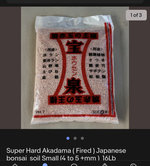Hmm…. Interesting thought.
Akadama in Japanese literally means
Red Ball. The last couple years I’ve seen some suppliers heat treat akadama to varying temperatures. It is possible these suppliers are trying to increase the durability of the material.… mine a new source…. or maybe market the previously rejected material
Kinda funny as both Akadama and Kanuma are stated to be broken down pumice… the suppliers are reversing the natural process.
Yet it’s not like crushed brick. The structure of Akadama/Kanuma actually allows roots to penetrate through the products. This continues as the akadama/Kanuma breaks down and the growing conditions slow down the tree growth as this occurs the tree roots are said to scale down into the smaller pieces, producing a fine fiberous root mass over time.
Last fall I received a bag of King Red Ball super heat treated akadama, stated to be heat treated over 800C. It’s hard, but wets down and becomes softer, yet not as soft as the other brands we receive… perhaps over time it will.

As opposed to the Double Red Line “Red Ball” many of are used to seeing.

If one wants to learn more here are two links.
Bonsai Tonight
Tachikawa- Heiwa company
cheers
DSD sends